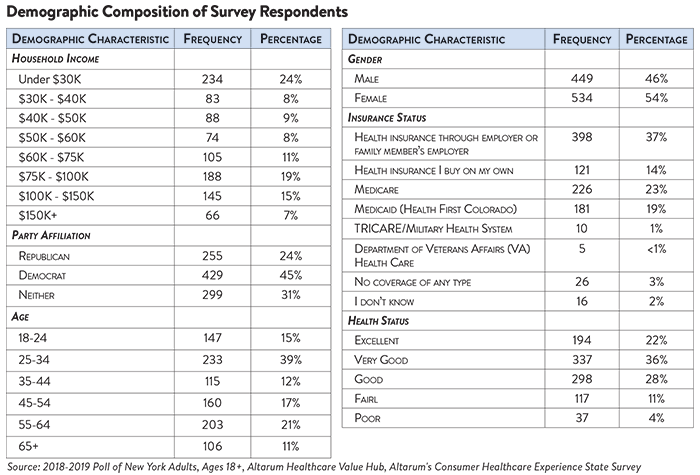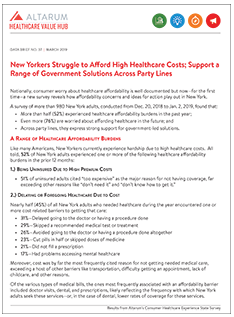New Yorkers Struggle to Afford High Healthcare Costs; Support a Range of Government Solutions Across Party Lines
Nationally, consumer worry about healthcare affordability is well documented but now—for the first time—a new survey reveals how affordability concerns and ideas for action play out in New York.
A survey of more than 980 New York adults, conducted from Dec. 20, 2018 to Jan. 2, 2019, found that:
- More than half (52%) experienced healthcare affordability burdens in the past year;
- Even more (76%) are worried about affording healthcare in the future; and
- Across party lines, they express strong support for government-led solutions.
A Range of Healthcare Affordability Burdens
Like many Americans, New Yorkers currently experience hardship due to high healthcare costs. All told, 52% of New York adults experienced one or more of the following healthcare affordability burdens in the prior 12 months:
1.) Being Uninsured Due to High Premium Costs
- 51% of uninsured adults cited “too expensive” as the major reason for not having coverage, far exceeding other reasons like “don’t need it” and “don’t know how to get it.”
2.) Delaying or Foregoing Healthcare Due to Cost
Nearly half (45%) of all New York adults who needed healthcare during the year encountered one or more cost related barriers to getting that care:
- 31%—Delayed going to the doctor or having a procedure done
- 29%—Skipped a recommended medical test or treatment
- 26%—Avoided going to the doctor or having a procedure done altogether
- 23%—Cut pills in half or skipped doses of medicine
- 21%—Did not fill a prescription
- 17%—Had problems accessing mental healthcare
Moreover, cost was by far the most frequently cited reason for not getting needed medical care, exceeding a host of other barriers like transportation, difficulty getting an appointment, lack of childcare, and other reasons.
Of the various types of medical bills, the ones most frequently associated with an affordability barrier included doctor visits, dental, and prescriptions, likely reflecting the frequency with which New York adults seek these services—or, in the case of dental, lower rates of coverage for these services.
3.) Struggling to Pay Medical Bills
In other cases, New Yorkers got the care they needed but then struggled to pay the resulting bill. More than one-third (35%) of New York adults experienced one or more of these struggles while paying off medical bills:
- 15%—Used up all or most of their savings
- 13%—Unable to pay for basic necessities like food, heat, or housing
- 12%—Contacted by a collection agency
- 9%—Borrowed money or got a loan or another mortgage on their home
- 7%—Racked up large amounts of credit card debt
- 6%—Placed on a long-term payment plan
High Levels of Worry About Affording Healthcare in the Future
In even greater numbers, New York adults worry about affording healthcare in the future.
Overall, more than three-fourths (76%) reported being “worried” or “very worried” about affording some aspect of healthcare in the future, including:
- 66%—Cost of nursing home and home care services
- 63%—Medical costs when elderly
- 62%—Cost of a serious illness or accident
- 57%—Prescription drug costs
In addition, most respondents (64%) were “worried” or “very worried” about not being able to afford health insurance in the future. The greatest concern was among those that buy private health coverage as individuals—over three-fourths of those adults were worried (see Figure 1). In addition, individual market enrollees and those on Medicaid were worried about losing their coverage.
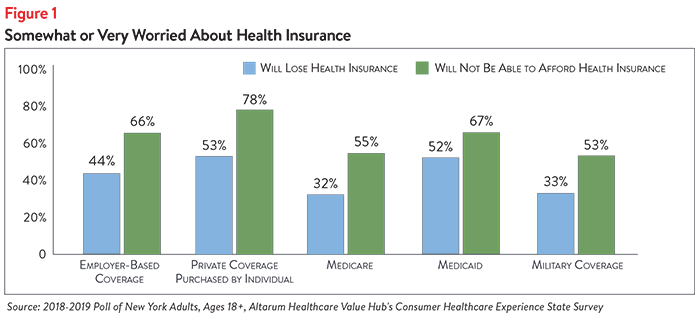
Healthcare Affordability Concerns by Income
Worries about affording healthcare go far up the income ladder. While lower-income households (less than $50K/year) have the highest levels of worry, two-thirds of high-income households (more than $100K/year) have healthcare affordability worries (see Table 1).
Middle-income households ($50K-$99K/year) report the highest levels of healthcare burdens during the past 12 months: avoiding needed care and/or struggling to pay their medical bills (see Figures 2 and 3).
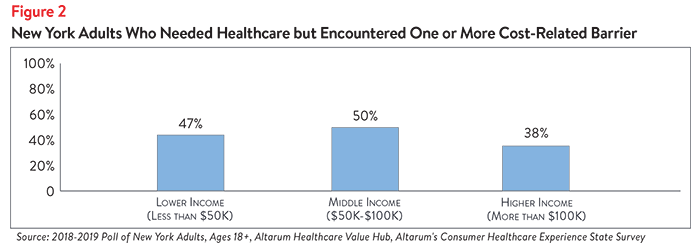

Healthcare Affordability Concerns by Insurance Type
Compared to publicly insured residents (those with Medicaid, Medicare, Tri-care and Veterans coverage), New York adults with private insurance from their employer or purchased on their own through the individual market report somewhat higher rates of worry and affordability burdens (see Figure 4).
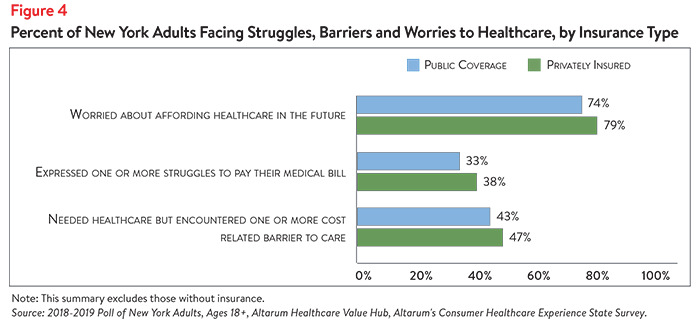
Healthcare Affordability Concerns by Region
The survey also revealed regional differences in how New York experiences healthcare affordability burdens. Responses were mapped into the regions in Table 2.

The New York City Boroughs reported the greatest rate of healthcare affordability burdens—59% of adults experienced one or more of the three types of burdens described above. In contrast, Long Island and Upstate New York were almost 10 percentage points lower (see Figure 5).
Perhaps reflecting these high rates of healthcare affordability burdens, residents of the New York City Boroughs also reported starkly higher levels for specific healthcare worries:
Worry about affording medical costs for the elderly spiked at 67% in the New York City Boroughs region, compared to 54% in the Long Island region.
Worry about affording the cost of a serious illness or accident spiked at 65% in the New York City Boroughs region, compared to 57% in the Long Island region.
But overall levels of worry about any healthcare burden was high across regions, ranging from 72% to 79%.
Additional detail and regional reports are available at: www.healthcarevaluehub.org/New York-2019-Healthcare-Survey/
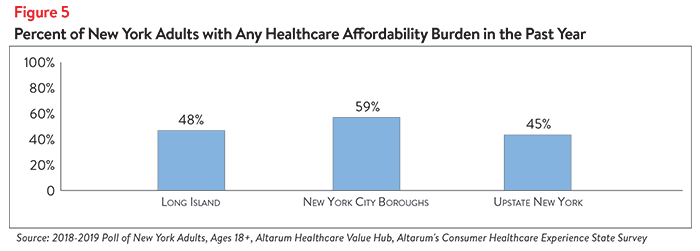
Dissatisfaction with the Health System and Support for Change
In light of these healthcare affordability concerns, it is not surprising that New Yorkers were extremely dissatisfied with the health system. Statewide:
- Just 32% agreed or strongly agreed with the statement “We have a great healthcare system in the U.S.,”
- While 72% agreed or strongly agreed “the system needs to change.”
The survey asked about both personal and governmental actions to address healthcare system problems.
Personal Actions
New Yorkers do see a role for themselves in addressing healthcare affordability. When asked to rank the top three personal actions would be most effective in addressing the affordability of healthcare (out of ten options), top vote getters were:
- 62%—Taking better care of their personal health
- 39%—Write or call my STATE representative asking them to take action
- 35%—Write or call my FEDERAL representative asking them to take action
- 37%—Research treatments myself, before going to the doctor
Respondents do see a role for themselves in solving problems. They reported actions they have already taken, like researching the cost of drug beforehand (43%), as well as actions they should be taking—66% believe that switching from a brand to a generic drug if given a chance is one of the top things they can do personally to address affordability
Government Actions
But far and away, New York residents see government as the key stakeholder that needs to act to address health system problems. Moreover, addressing healthcare problems trumps other issues that New Yorkers want their elected representatives to work on.
At the beginning of the survey, respondents were asked what issues the government should address in the upcoming year. Healthcare was the most frequently cited issue, far exceeding eight other options. The top vote getters were:
- 62%—Healthcare
- 43%—Taxes
- 39%—Economy/Joblessness
When asked about the top three healthcare priorities the government should work on, top vote getters were:
- 46%—addressing high healthcare costs including prescription drugs;
- 34%—getting health insurance to those who cannot afford coverage; and
- 31%—preserving consumer protections like: you can’t be denied coverage or charged more if you have a pre-existing medical condition.
Of more than 20 options, New Yorkers believe the problem causing high healthcare costs is unfair prices charged by powerful industry stakeholders.
- 69%—Insurance companies charging too much money
- 69%—Hospitals charging too much money
- 68%—Drug companies charging too much money
- 56%—Some well-known or large hospitals or doctor groups using their influence to get higher payments from insurance companies
When it comes to tackling costs, respondents endorsed a number of strategies, including:
- 93%—Make it easy to switch insurers if a health plan drops your doctor
- 90%—Require hospitals and doctors to provide up front patient cost estimates
- 90%—Require insurers to provide upfront cost estimates to consumers
Support for Action Across Party Lines
What is remarkable about the findings is high support for change regardless of the respondent’s political affiliation (see Table 3).
The high burden of healthcare affordability, along with high levels of support for change, suggest that elected leaders and other stakeholders need to make addressing this consumer burden a top priority. Annual surveys can help assess whether or not progress is being made.
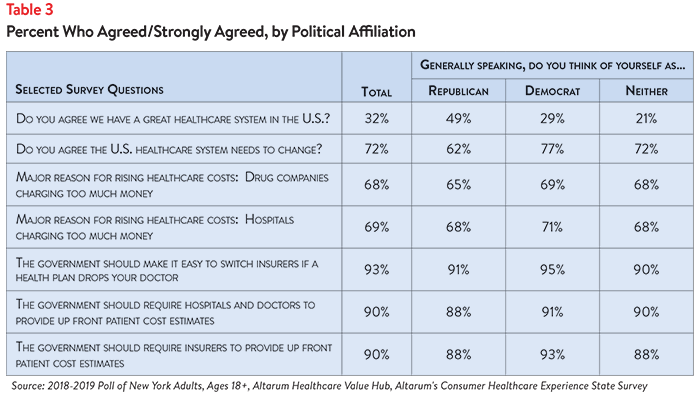
Methodology
Altarum’s Consumer Healthcare Experience State Survey (CHESS) is designed to elicit respondents’ unbiased views on a wide range of health system issues, including confidence using the health system, financial burden, and views on fixes that might be needed.
The survey used a web panel from SSI Research Now with a demographically balanced sample of approximately 1,000 respondents who live in New York. The survey was conducted only in English and restricted to adults ages 18 and older. Respondents who finished the survey in less than half the median time were excluded from the final sample, leaving 983 cases for analysis with sample balancing occurring in age, gender and income to be demographically representative of New York. After those exclusions, the demographic composition of respondents was as follow.
